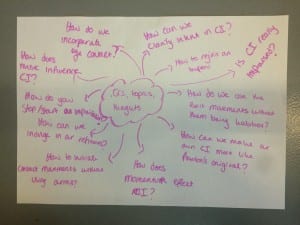During last week’s lesson we looked upon weight distribution towards the end of the class, for me personally I struggled I couldn’t grasp the idea of somebody carrying my entire weight.
This week was different we looked at different ways of transitioning through contact:
- Handstand
- Released side rolls
- Half handstand with legs lowered in a deep second
- Cartwheel with flexed legs
- Grounded leg spin
After doing these positions several times I noticed myself feeling a lot more confident with my weight and where to place it. So doing the next task ‘points of contact’ felt a lot easier this week, only with the weight distribution because I felt a lot more in control of myself, knowing that if I can handle my own weight then possibly somebody else could too. There were definitely times when I thought with certain people that I could experiment with the lifts, this lead me to involuntary just give them my weight.
The outcome for this was good to experience in the moment as I also had to figure a way out a way to come out of the lift while remaining in contact. As I went on to change partners I did notice I had taken the role as the over dance and even though I felt adventurous with my lifts, I didn’t want to be predictable now that I was aware of other transactions. How can I experiment with my weight as the under dancer is still basic? Saying this am I still being basic if I’m the under dance? Maybe that’s what we need to work on as a class to see how we can develop different stances.
Our final task became a group one; helping each other to be comfortable with just giving our weight. Getting in a big circle and having to stand in the middle, counting down from 3 while people catch you is nerve wrecking but going through it myself, didn’t seem so bad. I think I may have been careful with my head weight so I didn’t fully release it, this may have been because the initial idea is to catch the person more than to gentle and place them down, so I was still being precautious. With so many of the activities being one on one partners and having their sole attention on you, I feel it’s difficult to feel relaxed with more people and things going on around me.
Ongoing Research Lab
What do I want to discover from Contact Improvisation?
As a group we decided to choose two questions we thought would benefit the class:
How do we incorporate eye contact? We’re using this question to see if it would change the way we feel while doing contact to the audience and performer.
Who initiates movement after a weight bearing position, the under or the over dancer? This is to look at it more reflectively, to see how one person can feel about each role.
Brown, B. (1997) Is Contact a Small Dance? Contact Quarterly: Contact Improvisation Sourcebook, 1(6) 72-75.
Ravn, S. (2010) Sensing Weight in Movement. Journal of Dance and Somatic Practices, 2(1) 21-34.

